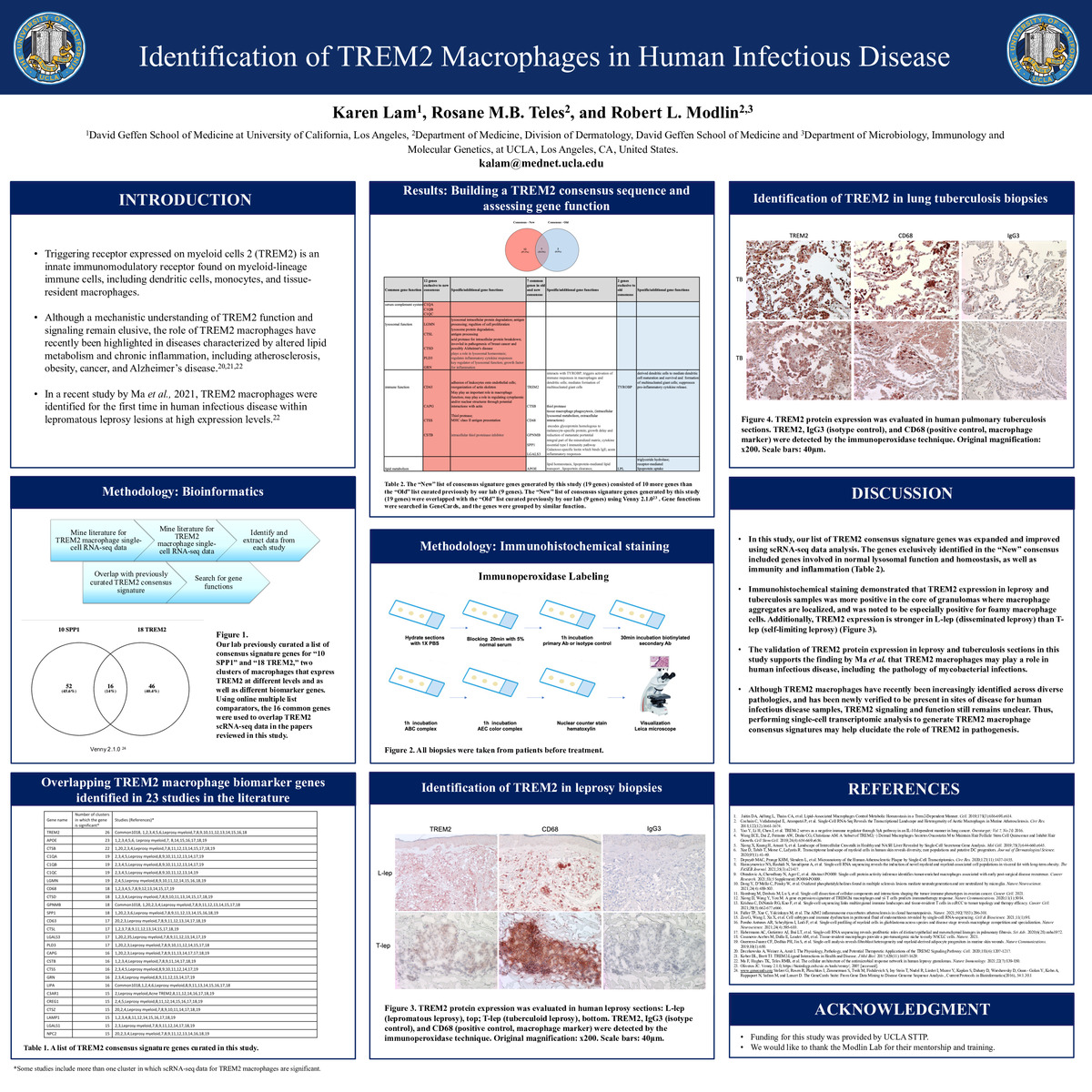-
Author
Karen Lam -
PI
Robert L. Modlin, M.D.
-
Co-Author
Karen Lam
-
Title
Identification of TREM2 Macrophages in Human Infectious Disease
-
Program
STTP
-
Other Program (if not listed above)
-
Abstract
Background: Triggering receptor expressed on myeloid cells 2 (TREM2) is an innate immunomodulatory receptor found on myeloid-lineage immune cells. Although a mechanistic understanding of TREM2 function and signaling remain elusive, the role of TREM2 macrophages have recently been highlighted in diseases characterized by altered lipid metabolism and chronic inflammation, including atherosclerosis, obesity, cancer, and Alzheimer’s disease. In a recent study by Ma et al., 2021, TREM2 macrophages were identified for the first time in human infectious disease within lepromatous leprosy lesions at high expression levels.
Aims: The aims of this study are to build a list of TREM2 macrophage consensus signature genes by surveying single-cell transcriptomic studies, including studies using human infectious models, and to subsequently verify the presence of TREM2-expressing cells in sites of disease for leprosy and pulmonary tuberculosis.
Methods: The literature was mined for studies that identified the presence of TREM2 macrophages in single-cell RNA sequencing (scRNA-seq) data. The newly identified signature genes for TREM2 macrophages were then overlapped with TREM2 consensus signature genes previously curated by our lab. Next, immunohistochemical staining using the immunoperoxidase technique was performed on leprosy and lung tuberculosis biopsy slides, samples which were taken from patients at the time of diagnosis before treatment. The biopsy slides were stained with specific TREM2 monoclonal antibodies and specific IgG isotype controls along with CD68 (macrophage marker) as a positive control. Pictures were taken using Leica A4 software.
Results: After reviewing the literature, 23 studies with available TREM2 macrophage scRNA-seq data were identified. Biomarker genes for TREM2 macrophages from these studies were then used to create a more comprehensive list of TREM2 macrophage consensus signature genes. Immunohistochemical staining demonstrated that TREM2 expression in leprosy and pulmonary tuberculosis samples were more positive in the core of granulomas where macrophage aggregates are localized and was noted to be especially positive for foamy macrophage cells.
Conclusion: Although TREM2 macrophages have recently been increasingly identified across diverse pathologies and has been newly verified to be present in sites of disease for human infectious disease samples, TREM2 signaling and function still remains unclear. Thus, performing single-cell transcriptomic analysis to generate TREM2 macrophage consensus signatures may help elucidate the role of TREM2 in pathogenesis. -
PDF
-
Zoom
https://uclahs.zoom.us/j/92220908645?pwd=Z3A3MTVIbjJpc0xiblh6V0ZmV0xwZz09

